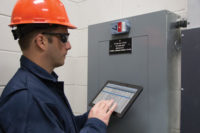Trends in industrial security
Integration ensures plant protection and safety compliance

Concerns about industrial safety and security have never been greater. Plant owners, operators and contractors need effective solutions to control facility access, safeguard assets, improve situational awareness, maintain regulatory compliance, and enhance emergency response.
Unfortunately, the traditional approach to safety as part of industrial security involves siloed systems with no clear visibility of actual site conditions. Corporate policies are driven by reactions to unplanned events.
By integrating safety and security programs, plant operating companies can assess, manage and mitigate the safety implications of industrial security in a connected enterprise.
Why integration?
At industrial facilities, strategies to protect people and assets have traditionally relied on disconnected, standalone solutions for critical activities such as alarming, emergency mustering, worker location monitoring, and fatigue management.
The current trend for plant operators is to deploy integrated solutions enabling them to connect, control and collaborate across the enterprise. With this approach, they can unify disparate platforms to optimize control, safety and security. Tightly integrating video surveillance and access control with alarms and events raised in process and safety systems allows for intelligent, coordinated responses.
A common, consistent operator interface will improve situational awareness to drive better and faster decisions while enabling operators to perform all system configuration, viewing, recording, archiving, and retrieval of video from the same station. A single security system login, meanwhile, simplifies the management of access privileges.
A holistic approach
In order to maximize plant effectiveness and ensure that the question “Are we well enough protected?” can be answered, a holistic approach to integrating personnel and asset safety is needed. This approach requires independent but interrelated layers of protection be in place across an organization.
The concept of layers of protection is widely recognized by the process industry, and the term is clearly defined in industry standards such as IEC 61508 and IEC 61511. Some layers of protection are preventative in nature, and some are there to mitigate the impact of an incident once it occurs. Other layers of protection can deter incidents in the first place, or provide detection and alerting, and associated guidance.
Working across the various layers of protection, a plant can operate in a secure and protected atmosphere. For instance, in the event of a fire or safety incident, alarms are integrated with industrial security at operator stations and, in parallel, trigger preventive measures such as electronic mustering for safe evacuation, generate mustering reports and automate the opening of fire exit doors.
Putting technology to work
A full array of advanced industrial safety and security solutions are available for integration with plant control systems to enable coverage from day one of construction through full plant operation. These solutions are essential tools for tasks such as emergency mustering, fatigue management and more. They include:
- Integrated security management platform: Plant operators are under pressure to increase situational awareness by integrating multiple technologies to obtain access to event-based information. They are required to understand, react and make informed decisions based on circumstances in a geographic context. An integrated security management platform, unified with the plant DCS, combines access control, alarm paging, digital video management and video surveillance in a common operator interface. It helps to deliver consistent responses and eliminate confusion under stressed conditions when concise actions and responses are required.
- Digitizing the workforce management: With the growing scale of operations, changing safety, security and regulatory requirements, ensuring worker readiness to do their job in compliance with organizational policies while maintaining efficiency is a crucial challenge. Digitizing your workforce management offer an integrated platform to enhance safety, security and productivity across an organization. They help improve productivity, safety and compliance for employees, contractors and visitors.
- Real-time location monitoring: When it comes to running an industrial facility, people always come first. Innovative technology is needed ensure safety and security, while supporting productivity improvement and accountability of personnel and processes. The latest wireless real-time location solutions provide actionable information to help optimize a plant’s workforce and assets. They can significantly shorten mustering time; reduce safety incidents by performing rules-based monitoring of worker fatigue and hazardous area movements; and increase personnel safety by providing break time monitoring, time-in-zone monitoring, etc.
- Facility command and control: With integrated incident workflows, rapid access to information, contextual awareness and ease-of-use, the latest command and control solutions can reduce risk to an industrial facility. They seamlessly integrate plant-wide resources so personnel can collaborate, command and control the facility with greater confidence.
Benefits to industrial organizations
Experience has shown tightly integrated safety and security solutions bring benefits throughout an industrial organization, for plant management, engineering and project teams, and emergency responders.
By incorporating advanced safety solutions as part of a comprehensive industrial security strategy, control room operators can improve alarm management while maintaining situational awareness and command and control of personnel and assets. Incidents and events are visible through deep integration of process, safety and fire & gas systems. In addition, operators can instantly monitor situations, isolate dangerous materials, or shutdown appropriate units.
Emergency responders can receive instant and live data from the plant in the event of a life safety event, enabling them to respond quicker with the proper equipment and personnel.
Security personnel can have immediate access to relevant data in case of a process-driven event, such as an explosion or toxic gas leak, which endangers personnel and assets.
EPC contractors can be confident of effective safety measures during construction, testing, commissioning, and start-up.
Ensuring industrial safety and security goes beyond installing standalone solutions. To achieve utmost protection, it is important to consider critical factors from all aspects of an operation.
Looking for a reprint of this article?
From high-res PDFs to custom plaques, order your copy today!








